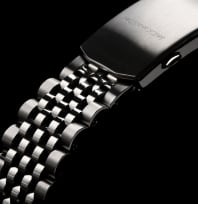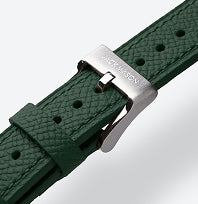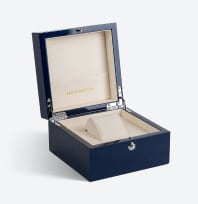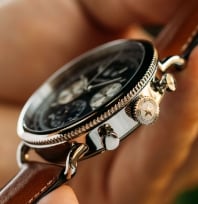Understanding Mechanical Watches From The Inside Out
Mechanical watch movement is the oldest and one of the most complex watch-powering mechanisms. Mechanical watches have been worn for centuries, predating automatic and quartz watches. For a long stretch of watchmaking history, mechanical wristwatches were the only variety available. These watches require manual winding by the wearer to keep ticking and telling time accurately.
In this post, we’ll take a look at the date complication found in many mechanical watches and determine how it works. Mechanical watches are incredibly intricate, and their inner workings function independently of any batteries or electronic components. Instead, these ingenious timepieces fully rely on a combination of tiny, interconnected mechanical parts. When it comes to complications like date displays, mechanical watches continue to rely on non-electronic parts.
Before we get started with digging into the inner workings of a mechanical watch’s date display, let’s first get familiar with how mechanical watches work. Prepare to be amazed!
When Were Mechanical Watches Invented?
Mechanical watch movement has been used by watchmakers for centuries. As the oldest form of watch movement, mechanical watchmaking is an art form and an impressive feat of craftsmanship. Mechanical watches are made using a combination of tiny parts, all of which serve specific, interconnected purposes in keeping the watch functioning properly.
The first mechanical watch was invented in the early 1500s, over half a millennium before the first automatic wristwatch. For centuries thereafter, watchmakers exclusively employed mechanical movement to craft watches. Mechanical watch movement has seen several key innovations since its invention in the 1500s, including the invention of the minute hand in the late 1600s.
Mechanical Watch Movement Explained
Mechanical watches stay ticking thanks to the retention of kinetic energy within a coiled piece of steel known as the mainspring. The mainspring releases energy in timed increments, allowing the watch to keep telling time accurately. This release of energy is regulated by the watch’s escapement. The escapement periodically allows the mainspring to be unwound at a specific rate.
The mainspring is attached to the escapement by a series of interconnected gears called the wheel train. The escapement keeps the gears of the wheel train in place until the balance wheel, the most fragile component of the watch, triggers the release of energy from the mainspring.
When a mechanical watch is wound, the wearer twists a knob called the crown on the exterior of the watch. Winding a mechanical watch coils the mainspring, building up energy that will be released in specific increments. A mechanical watch needs to be wound periodically to keep it ticking.
This need for manual winding makes a mechanical watch higher maintenance than a quartz or automatic watch. However, even “self-winding” automatic watches can sometimes require manual winding if they are left unworn for long periods of time.
The Bridges Of A Mechanical Watch
A mechanical watch’s parts are carefully layered on top of each other in sections called bridges. These layers of components are all interconnected with each other, with the mainspring being the centerpiece of the watch’s winding mechanism. The bridges of a mechanical watch’s inner workings are called the balance bridge, pallet bridge, wheel train bridge, and barrel bridge.
The balance bridge contains the balance wheel, a fragile oscillating wheel that rotates in timed increments to trigger the release of the wheel train. The wheel train’s gears are hindered from moving by the escapement, which keeps a mechanical watch accurate by releasing the wheel train and unwinding the mainspring at specific times. The balance wheel is the most delicate part of a mechanical watch and needs to be fitted with a special protective mechanism to keep it intact in case the watch is dropped.
The pallet bridge sits directly on top of the balance bridge, holding the pallet fork. The pallet fork is the part of the escapement mechanism that holds and releases the escape wheel, allowing the wheel train to spin and unwind the mainspring. As the mainspring unwinds in carefully timed increments, the watch’s hands spin, accurately displaying the time within a few seconds of the margin of error.
Above the pallet bridge is the wheel train bridge. This section of the watch serves as the connection point between the escapement and the mainspring. The wheel train is a set of carefully layered gears that spin when the escapement releases the escape wheel from where it is held by the pallet fork. As the balance wheel spins in the balance bridge, the pallet fork in the pallet bridge releases its hold on the escape wheel, allowing the mainspring to unwind. As the pallet fork releases the escape wheel, the “tick” of the watch occurs as the teeth of the escape wheel catch on the pallet fork.
The topmost bridge of the layers of the mechanical watch’s inner workings is the barrel bridge, which houses the mainspring. As the escapement triggers the release of energy from the mainspring, the watch’s hands turn, maintaining the watch’s accuracy. In addition, the watch’s mainspring also regulates time-sensitive complications like a date display.

Types Of Date Displays On Mechanical Watches
Mechanical watch complications, including date displays, are regulated by additional gears and mechanical components within a watch. Complications provide a watch wearer with additional useful functions that can be accessed via a watch’s face. Because mechanical watches function without any electronic components, any complications featured on the face of a mechanical watch will be entirely analog.
The two primary types of date complications found on watches are annual calendars and perpetual calendars.
Annual date complications are commonly found on mechanical watches. This type of date complication is the simplest possible, relying on a mechanical date wheel. Annual calendars display the day of the week, month, and date in a compact interface. One of the primary drawbacks of an annual date complication is the need to reset the calendar during the month of February. These calendar complications are designed to accurately track 30-day and 31-day months but need to be manually adjusted during the 28 or 29-day month of February.
Perpetual calendars are designed to compensate for any changes to the number of days in a specific year, keeping the accurate date even during leap years. These types of date display complications are much more sophisticated and elaborate than the classic annual calendar.
Perpetual calendars are calibrated to accurately track the number of days a year for up to a century, meaning their displays will not be adjusted for an entire lifetime. Perpetual calendar displays are more common in automatic and quartz watches than in mechanical watches and are a more recent invention.
How Annual Calendars Work
If a mechanical watch features a date display complication, it is likely an annual calendar. This type of calendar display can be manually adjusted by the wearer, similarly to how a mechanical watch can be manually wound. This type of calendar relies on a date wheel, a cycling string of printed numeric elements that periodically switch out every 24 hours.
Winding a mechanical watch with an annual calendar complication requires precision. The date wheel in an annual calendar needs to be carefully adjusted to stay accurate, and haphazardly winding a mechanical watch can throw the watch’s accuracy off balance. In contrast, the date complications on automatic and quartz watches are largely hands-off, with the exception of a few specific circumstances.
Mechanical Watches Today
As you might imagine, the advent of new, innovative watch movements has rendered mechanical watches somewhat obsolete. While still worn by some collectors and enthusiasts, mechanical watches are largely considered to be collector’s items and family heirlooms.
Both quartz watches and automatic watches can be designed to include date displays, and these complications are often easier to interact with and maintain than the calendars featured on mechanical watches. This simplicity and ease of use make automatic and quartz watches preferable for most watch-wearers.
If you are lucky enough to own a mechanical watch, it is well worth holding onto. Mechanical watches can be incredibly rare and valuable, making them ideal family heirlooms and sought-after collectibles. However, a mechanical watch may not be the best candidate for your go-to everyday watch.
When it comes to convenience and low-maintenance wearability, automatic and quartz watches are far and away your best options. These watches have held up as the decades have passed, staying relevant and highly fashionable, even with the advent of digital and smartwatches.
When you are looking for a watch that can tell you both the date and time, you don’t need to settle for a digital or smartwatch. Instead, go for a high-quality automatic or quartz watch with a date display complication.
Even in the age of smartwatches, analog wristwatches continue to be the most fashionable and timeless option, easy to pair with a wide variety of looks and suitable for many occasions. As decades have gone by, analog watches have remained mainstays in men’s fashion, and they’re not going anywhere anytime soon.
Sources:
https://www.theatlantic.com/international/archive/2015/05/history-wristwatch-apple-watch/391424/











